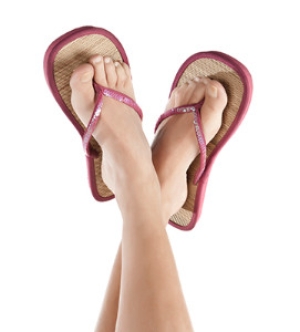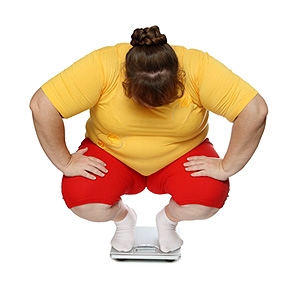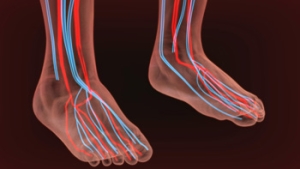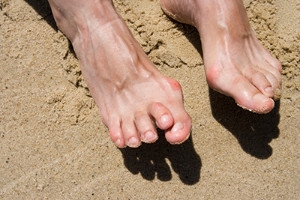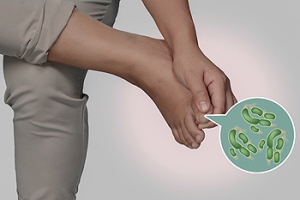
Differences between Walking and Running Shoes
Both running and walking are great exercises, but should a person wear the same shoes for both activities? The answer is no, because there is a difference between the way a person’s feet hit the ground when they are walking and when they are running. Therefore, the shoes for each activity are designed differently. Before you begin any exercise program it is always recommended that you speak with your doctor or podiatrist.
Walking is a low impact exercise that is often recommended by doctors to their patients. While walking is a simple activity, it still requires some degree of preparation. If you think about walking and how your feet strike the ground as you move, you will notice that your heel hits the ground first before your foot continues to roll forward and your next step begins. Because of this rolling motion, walking shoes are designed to be more flexible than running shoes. This flexibility helps the walker push off with each step taken.
Because the heel hits the ground first when you walk, walking shoes are designed to absorb most of the shock. Walking shoes should therefore have a beveled or angled heel. The angle of the heel helps absorb the shock and reduces pressure from the ankles. This is especially important for speed walkers, as their feet will hit the ground twice as often as the normal walker.
When people decide to run as a hobby or for their health, they must first realize that running is a high impact exercise. If not done with the proper equipment, running may cause damage to the feet and legs. Running shoes are designed to be more lightweight and to have thicker soles. The thicker soles act as shock absorbers for the rest of the body. Walking shoes often do not have the proper arch support that running shoes do.
A proper fitting shoe can make or break a runner or a walker. If the shoes are too big, their feet will slide back and forth inside the shoe and cause blisters. Whether you will be running or walking, the right equipment can make all of the difference in the world.
Plantar Fasciitis and Flip Flops
 Recent research has shown that wearing specific types of flip flops may be beneficial in relieving some of the the discomfort that is associated with plantar fasciitis. There are several types of flip flops that may offer proper arch support, are easily worn, and are convenient to wear. When choosing to purchase this type of shoe, the importance of looking for specific features may be crucial in maintaining comfort and stability that is needed for daily activities. These may include insuring that there is a deep area the heel can fit comfortably in, in addition to having the arch supported properly. If you are afflicted with plantar fasciitis, it’s suggested to speak with a podiatrist who can properly evaluate this ailment and advise you on correct treatment options.
Recent research has shown that wearing specific types of flip flops may be beneficial in relieving some of the the discomfort that is associated with plantar fasciitis. There are several types of flip flops that may offer proper arch support, are easily worn, and are convenient to wear. When choosing to purchase this type of shoe, the importance of looking for specific features may be crucial in maintaining comfort and stability that is needed for daily activities. These may include insuring that there is a deep area the heel can fit comfortably in, in addition to having the arch supported properly. If you are afflicted with plantar fasciitis, it’s suggested to speak with a podiatrist who can properly evaluate this ailment and advise you on correct treatment options.
Flip-flops can cause a lot of problems for your feet. If you have any concerns about your feet or ankles, contact one of our podiatrists from New York Foot and Ankle. Our doctors will assist you with all of your foot and ankle needs.
Flip-Flops and Feet
Flip-flops have managed to become a summer essential for a lot of people. While the shoes may be stylish and easy to slip on and off, they can be dangerous to those who wear them too often. These shoes might protect you from fungal infections such as athlete’s foot, but they can also give you foot pain and sprained ankles if you trip while wearing them.
When Are They Okay to Wear?
Flip-flops should only be worn for very short periods of time. They can help protect your feet in places that are crawling with fungi, such as gym locker rooms. Athlete’s foot and plantar warts are two common fungi that flip-flops may help protect your feet against.
Why Are They Bad for My Feet?
These shoes do not offer any arch support, so they are not ideal for everyday use. They also do not provide shock absorption or heel cushioning which can be problematic for your feet. Additionally, you may suffer from glass cuts, puncture wounds, and stubbed toes since they offer little protection for your feet.
More Reasons Why They Are Bad for Your Feet
- They Slow You Down
- May Cause Blisters and Calluses
- Expose Your Feet to Bacteria
If you have any questions, please feel free to contact one of our offices located in Franklin Square, Bethpage, Brooklyn, and Massapequa, NY . We offer the newest diagnostic and treatment technologies for all your foot care needs.
Flipping Out About Flip Flops
Although it may be tempting to wear flip-flops in warm weather, they are not the best choice of footwear for your feet. Flip-flops may be ideal for the beach, pool, spa, and shared showers, but you should avoid wearing them unless it is completely necessary.
Flip-flops only have a small strip of fabric holding your foot in place, but your toes need a better grip to keep your foot in place. The repetitive gripping can lead to an overuse of your muscles, which could result in tendinitis. This is only one of the many problems that stem from wearing flip-flops too often.
Flip flops aren’t good for extensive walking because they fail to offer arch support, heel cushioning, or shock absorption. As a result, people who wear flip flops are at a higher risk of experiencing an ankle sprain. Additionally, these shoes offer little protection for your feet, putting those who wear them at a greater risk for stubbed toes, glass cuts, and puncture wounds.
Although flip flops aren’t recommended for everyday use by anyone, it is especially important for diabetics to avoid them. A diabetic foot injury can easily become very serious, and it may even lead to amputation.
If you are experiencing pain from wearing flip-flops, you shouldn’t be hesitant to replace them with a more comfortable shoe that offers more support. If your flip-flop foot pain doesn’t go away, you should seek assistance from a podiatrist right away. It is possible that you may have a more serious foot problem such as a stress fracture or arthritis.
Specific Foot Conditions May Be The Result of Obesity
 Research has shown that many people who are overweight may suffer from chronic foot pain. This may be a result of the additional weight the feet must endure, which may often lead to uncomfortable foot conditions. There are several ailments that may affect the feet. These may include low or absent arches, the feet turning inward or outward, or pain that involves the plantar fascia. This is the band of tissue that runs along the bottom of the foot. The additional weight may cause this part of the foot to become inflamed, and the result may be severe pain and discomfort. Many obese people may find it difficult to exercise and this may lead to poor circulation, joint pain, or limited mobility. A painful form of arthritis referred to as gout may be common among people who are obese and this is typically the result of excess uric acid in the blood levels. It’s suggested to speak with a podiatrist if you are overweight and have concerns about specific foot conditions.
Research has shown that many people who are overweight may suffer from chronic foot pain. This may be a result of the additional weight the feet must endure, which may often lead to uncomfortable foot conditions. There are several ailments that may affect the feet. These may include low or absent arches, the feet turning inward or outward, or pain that involves the plantar fascia. This is the band of tissue that runs along the bottom of the foot. The additional weight may cause this part of the foot to become inflamed, and the result may be severe pain and discomfort. Many obese people may find it difficult to exercise and this may lead to poor circulation, joint pain, or limited mobility. A painful form of arthritis referred to as gout may be common among people who are obese and this is typically the result of excess uric acid in the blood levels. It’s suggested to speak with a podiatrist if you are overweight and have concerns about specific foot conditions.
Obesity has become very problematic at this point in time and can have extremely negative effects on the feet. If you’re an obese individual and are concerned about your feet, contact one of our podiatrists from New York Foot and Ankle. Our doctors can provide the care you need to keep you pain-free and on your feet.
Obesity and Your Feet
Since your feet are what support your entire weight when standing, any additional weight can result in pain and swelling. Being overweight is one of the main contributors to foot complications.
Problems & Complications
Extra Weight – Even putting on just a few extra pounds could create serious complications for your feet. As your weight increases, your balance and body will shift, creating new stresses on your feet. This uneven weight distribution can cause pain, even while doing the simplest tasks, such as walking.
Diabetes – People who are overweight are at serious risk of developing type-2 diabetes, which has a drastic impact on the health of your feet. As you get older, your diabetes might worsen, which could lead to loss of feeling in your feet, sores, and bruises. You could also become more prone to various infections.
Plantar fasciitis – Pressure and stress that is placed on muscles, joints, and tendons can trigger plantar fasciitis, which is an inflammation of tissue that forms along the bottom of the foot.
If you have any questions please feel free to contact one of our offices located in Franklin Square, Bethpage, Brooklyn, and Massapequa, NY . We offer the newest diagnostic and treatment technologies for all your foot and ankle needs.
How Obesity Affects Your Feet
Gaining weight can happen suddenly and at any time. Usually you won’t notice the extra weight until your feet start hurting at the end of the day. This happens as your feet begin adjusting to carrying more weight. Foot swelling and pain are two of the biggest side effects of having gained weight.
Many foot-related problems can occur even after just putting on a few pounds. This includes the body ‘compensating’ by changing the way it moves. You may find yourself putting extra weight on the wrong parts of your feet and even leaning forward a bit. Your feet were designed to carry a healthy, normal body weight. Extra weight places undue stress on them.
Being overweight often causes the development of Type-2 diabetes, causing leg and foot pain. Older people who do not attempt to control their condition can even lose sensation and feeling in their legs and feet. This can lead to the development of small sores that can lead to serious infection.
Extra stress placed on the joints, tendons and muscles in the feet as a result of extra body weight may also cause heel spurs, or plantar fasciitis. Plantar fasciitis is an inflammation of the foot tissue, causing stiffness and pain when walking and climbing stairs. This can usually be relieved by foot stretches and custom made orthotic shoe-inserts.
Problems in the feet triggered by obesity can be treated by paying special attention to footwear. Proper support shoes that allow for good circulation, especially in the arch and ankle, are vital. A podiatrist can help you find what sort of shoe is most suitable for your feet. They can also measure you for special orthotics if necessary.
It could also be high time to start losing weight in order to treat and prevent diabetes as well as other life threatening diseases. Some methods include yoga and water aerobics, which benefit your entire body without placing stress on your feet. Don’t risk losing your feet by losing interest in them. Take care of your feet and your body, as they deserve the very best.
Causes of Poor Circulation
 Research has shown there are many people that may experience poor circulation in their feet. Some of the symptoms that may be associated with this ailment may be muscle cramps, feeling a tingling or numbing sensation, or possible sharp pains that may be felt in the feet. A condition that is referred to as peripheral artery disease, also known as PAD, may be a common cause of poor circulation. This typically causes the arteries to become narrow, which may result in nerve damage. Obesity may be an additional reason why poor circulation may occur. The feet must endure additional weight, which may lead to difficulty in exercising, and this may contribute to poor circulation. It’s important to speak with a podiatrist if you feel you are afflicted with poor circulation in the feet.
Research has shown there are many people that may experience poor circulation in their feet. Some of the symptoms that may be associated with this ailment may be muscle cramps, feeling a tingling or numbing sensation, or possible sharp pains that may be felt in the feet. A condition that is referred to as peripheral artery disease, also known as PAD, may be a common cause of poor circulation. This typically causes the arteries to become narrow, which may result in nerve damage. Obesity may be an additional reason why poor circulation may occur. The feet must endure additional weight, which may lead to difficulty in exercising, and this may contribute to poor circulation. It’s important to speak with a podiatrist if you feel you are afflicted with poor circulation in the feet.
While poor circulation itself isn’t a condition; it is a symptom of another underlying health condition you may have. If you have any concerns with poor circulation in your feet contact one of our podiatrists of New York Foot and Ankle. Our doctors will treat your foot and ankle needs.
Poor Circulation in the Feet
Peripheral artery disease (PAD) can potentially lead to poor circulation in the lower extremities. PAD is a condition that causes the blood vessels and arteries to narrow. In a linked condition called atherosclerosis, the arteries stiffen up due to a buildup of plaque in the arteries and blood vessels. These two conditions can cause a decrease in the amount of blood that flows to your extremities, therefore resulting in pain.
Symptoms
Some of the most common symptoms of poor circulation are:
- Numbness
- Tingling
- Throbbing or stinging pain in limbs
- Pain
- Muscle Cramps
Treatment for poor circulation often depends on the underlying condition that causes it. Methods for treatment may include insulin for diabetes, special exercise programs, surgery for varicose veins, or compression socks for swollen legs.
As always, see a podiatrist as he or she will assist in finding a regimen that suits you. A podiatrist can also prescribe you any needed medication.
If you have any questions, please feel free to contact one of our offices located in Franklin Square, Bethpage, Brooklyn, and Massapequa, NY . We offer the newest diagnostic and treatment technologies for all your foot care needs.
Causes Symptoms and Treatment for Poor Circulation in the Feet
The purpose of the body’s circulation system is to transport blood, oxygen, and nutrients throughout the body. A reduction of blood to a specific part of the body may cause one to experience symptoms of poor circulation. The most common causes of poor circulation in the feet are obesity, diabetes, and heart conditions such as peripheral artery disease (PAD). Common symptoms of poor circulation include tingling, numbness, throbbing, pain and muscle cramps.
Peripheral artery disease is a common cause of poor circulation in the legs. Symptoms of PAD are cramping, pain or tiredness in the leg or hip muscles while walking or climbing stairs. This pain tends to go away with rest and starts back up when you begin to walk. It is a condition that causes the blood vessels and arteries to become narrow. Although PAD is more common in adults over the age of 50, it may also occur in younger people. A similar condition called atherosclerosis causes arteries to stiffen up due to a buildup of plaque in the arteries and blood vessels.
Blood clots are also a common cause of poor circulation in the feet. Clots may obstruct blood vessels and if they occur in the legs, they may eventually lead to pain and discoloration. This occurrence is commonly known as deep vein thrombosis (DVT) and it may travel to the lungs. Varicose veins are another condition that may lead to poor circulation, and it is caused by incompetence of the valves in the veins. Women who are overweight are prone to developing this condition. Lastly, diabetes, which is correlated with poor blood sugar metabolism may lead to chronic poor circulation. Those with diabetes often suffer from cramping in the legs, calves, thighs and buttocks.
If you are looking for ways to avoid poor circulation there are some tips you can follow. One tip is to avoid sitting for too long. If you plan to sit down for a long period of time, you should try standing up occasionally, to improve your circulation. Another great way to avoid poor circulation is to exercise. Exercise is an excellent way to pump the heart and increase blood flow. Those who suffer from poor circulation should also avoid smoking, reduce their salt intake, and try to lose weight.
If you are experiencing symptoms from poor circulation in your feet, you should consult with your podiatrist to determine the best method for treatment for you. He or she may prescribe medication in addition to recommending specific lifestyle changes to improve your circulation.
Is Hammertoe Uncomfortable?
 If you have ever worn narrow, pointed-toe shoes, you may be a candidate to develop hammertoe. The characteristics are a noticeable deformity that affects the middle toes, and may cause severe pain and discomfort. The toes may be bent at the middle joint and face downward, giving the appearance of a hammer. The surrounding muscles may become unbalanced, and this may cause difficulty in straightening the toes. This condition may become worse if prompt treatment is not administered, which may consist of performing simple exercises that may strengthen the foot and toes. Research has shown the most common cause of hammertoe is related to incorrect shoes that are worn. Additionally, there may be other reasons why this ailment may develop, including having an elongated second toe, incurring an injury to the toes, or genetic traits may play a significant role. If you are afflicted with hammertoe, it’s strongly suggested that you seek the counsel of a podiatrist for a complete diagnosis and to gather information about proper treatment options.
If you have ever worn narrow, pointed-toe shoes, you may be a candidate to develop hammertoe. The characteristics are a noticeable deformity that affects the middle toes, and may cause severe pain and discomfort. The toes may be bent at the middle joint and face downward, giving the appearance of a hammer. The surrounding muscles may become unbalanced, and this may cause difficulty in straightening the toes. This condition may become worse if prompt treatment is not administered, which may consist of performing simple exercises that may strengthen the foot and toes. Research has shown the most common cause of hammertoe is related to incorrect shoes that are worn. Additionally, there may be other reasons why this ailment may develop, including having an elongated second toe, incurring an injury to the toes, or genetic traits may play a significant role. If you are afflicted with hammertoe, it’s strongly suggested that you seek the counsel of a podiatrist for a complete diagnosis and to gather information about proper treatment options.
Hammertoes can be a painful condition to live with. For more information, contact one of our podiatrists of New York Foot and Ankle. Our doctors will answer any of your foot- and ankle-related questions.
Hammertoe
Hammertoe is a foot deformity that occurs due to an imbalance in the muscles, tendons, or ligaments that normally hold the toe straight. It can be caused by the type of shoes you wear, your foot structure, trauma, and certain disease processes.
Symptoms
- Painful and/or difficult toe movement
- Swelling
- Joint stiffness
- Calluses/Corns
- Physical deformity
Risk Factors
- Age – The risk of hammertoe increases with age
- Sex – Women are more likely to have hammertoe compared to men
- Toe Length – You are more likely to develop hammertoe if your second toe is longer than your big toe
- Certain Diseases – Arthritis and diabetes may make you more likely to develop hammertoe
Treatment
If you have hammertoe, you should change into a more comfortable shoe that provides enough room for your toes. Exercises such as picking up marbles may strengthen and stretch your toe muscles. Nevertheless, it is important to seek assistance from a podiatrist in order to determine the severity of your hammertoe and see which treatment option will work best for you.
If you have any questions, please feel free to contact one of our offices located in Franklin Square, Bethpage, Brooklyn, and Massapequa, NY . We offer the newest diagnostic and treatment technologies for all your foot care needs.
Hammertoe
Hammertoe is a foot deformity that occurs due to an imbalance in the tendons, muscles, or ligaments that are responsible for holding the toes in their normal position. This condition may be caused by poor footwear, foot structure, trauma, and disease. The most common solution for hammertoe is to relieve the pain by changing your footwear and wearing orthotics. In severe cases, surgery may be required.
The shoes that are most likely to cause hammertoe are high heeled shoes or shoes that are too tight in the toe box. Tight shoes will force your toes to crowd together in a curled position. This position will likely continue when you take your shoes off. Another cause is trauma. When you stub your toe, you are increasing the chance that you will develop hammertoe.
There are risk factors that may make you more likely to develop this condition. Women are more likely to have the condition compared to men, and it is also more likely to appear in those who are older in age.
Many different foot problems can be avoided by wearing shoes that have adjustability, adequate toe room, and low heels. Furthermore, if you want to buy new shoes, you should look to purchase them at the end of the day and make sure you know your correct size. The importance of buying shoes at the end of the day is that your feet swell as the day progresses. You should also ensure that you are wearing your correct size because your shoe size may change as you grow older.
To diagnose someone with hammertoe, your podiatrist will need to conduct a thorough examination of your foot. Your doctor may even order an x-ray to evaluate the bones and joints of your feet and toes.
If you have hammertoe, your podiatrist may recommend that you wear shoes that fit you better along with inserts to place inside them. Additionally, he or she may suggest special exercises for you to perform to stretch your toes. One helpful exercise it to pick up marbles with your feet or crumple a towel with your toes.
Prior to meeting with your podiatrist, it will be helpful to make a list of all the symptoms you are experiencing. You should also make a note of medications you are taking and important personal information about your medical history.
Causes of Athlete’s Foot
 The uncomfortable condition that is known as athlete’s foot may typically have noticeable symptoms, which may include red and itchy skin. This may develop in between the toes or on the sole of the foot and is known to be a common fungal infection. This contagious foot ailment can be spread by direct contact with another person or from walking on wet floors, including shower and pool areas. There may be several preventative measures that can be practiced, which may avoid the onset of athlete’s foot. These may include washing and drying the feet thoroughly, changing socks promptly if they become wet, and wearing shoes that are made of breathable materials. If you feel you have contracted athlete’s foot, it’s advised to consult with a podiatrist who can suggest the best course of treatment that will provide relief.
The uncomfortable condition that is known as athlete’s foot may typically have noticeable symptoms, which may include red and itchy skin. This may develop in between the toes or on the sole of the foot and is known to be a common fungal infection. This contagious foot ailment can be spread by direct contact with another person or from walking on wet floors, including shower and pool areas. There may be several preventative measures that can be practiced, which may avoid the onset of athlete’s foot. These may include washing and drying the feet thoroughly, changing socks promptly if they become wet, and wearing shoes that are made of breathable materials. If you feel you have contracted athlete’s foot, it’s advised to consult with a podiatrist who can suggest the best course of treatment that will provide relief.
Athlete’s foot is an inconvenient condition that can be easily reduced with the proper treatment. If you have any concerns about your feet and ankles, contact one of our podiatrists from New York Foot and Ankle. Our doctors will treat your foot and ankle needs.
Athlete’s Foot: The Sole Story
Athlete's foot, also known as tinea pedis, can be an extremely contagious foot infection. It is commonly contracted in public changing areas and bathrooms, dormitory style living quarters, around locker rooms and public swimming pools, or anywhere your feet often come into contact with other people.
Solutions to Combat Athlete’s Foot
- Hydrate your feet by using lotion
- Exfoliate
- Buff off nails
- Use of anti-fungal products
- Examine your feet and visit your doctor if any suspicious blisters or cuts develop
Athlete’s foot can cause many irritating symptoms such as dry and flaking skin, itching, and redness. Some more severe symptoms can include bleeding and cracked skin, intense itching and burning, and even pain when walking. In the worst cases, Athlete’s foot can cause blistering as well. Speak to your podiatrist for a better understanding of the different causes of Athlete’s foot, as well as help in determining which treatment options are best for you.
If you have any questions please feel free to contact one of our offices located in Franklin Square, Bethpage, Brooklyn, and Massapequa, NY . We offer the newest diagnostic and treatment technologies for all your foot and ankle needs.
